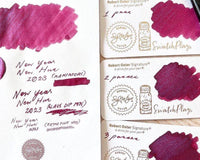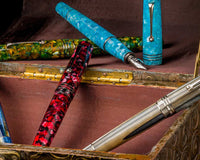Most people who use fountain pens begin with the typical round nib, which creates a monoline. The line thickness will be the same regardless of the writing direction or amount of pressure applied to the tines. This applies to all of the most popular nib sizes, including EF, F, M, and B.
Most people who use fountain pens will also begin to foray into writing with more line variation. In this case, it is useful to start with stub and italic nibs. Here, we briefly discuss the difference between the two and offer recommendations that beginners can try.
Italic vs Stub nibs
When choosing the right nib for you, it is important to know the difference between the italic and the stub.
Stub nibs achieve line variation as a result of their unique nib design. A stub nib's tipping is flattened into a rectangular shape. As a result, the stub creates a thick downward stroke and a narrow horizontal line. Stub nib widths range from 0.6mm to 2.3mm, which is the measurement of the downstroke. The broader the nib, the more line variation you’ll get as more ink is placed on the page.
Italic nibs resemble stub nibs quite a bit, but with a slight variation. Stub nibs have rounded corners to make writing more comfortable. On the other hand, italic nibs have sharper edges to emphasize the variety in the lines. These nibs tend to give more feedback, and it may be more difficult to find the sweet spot when you’re writing with an italic.
Now that you know the main difference between the two, here are some great beginner nibs to get you started:
1. Pilot Metropolitan stub

The famed Pilot Metropolitan fountain pen has a modest stub nib measuring just 1.0 mm. This is quite thinner than the usual 1.1 or 1.5 mm stub nibs. This is great for beginners because it gives you some nice line variation without being too unwieldy.
2. LAMY stub nibs

The great thing about LAMY stub nibs is that they are easily interchangeable between pen models such as Safari, AL-Star, Vista, or Joy. Simply slip off your normal nib and slide the stub nib of your choice on the pen. We recommend getting used to the 1.1 mm stub before moving onto wider nibs that are more suited for calligraphy, such as the 1.5 mm.
3. JoWo 1.5mm stub

JoWo nibs are some of the most affordable yet high-quality nibs that are made today. Many brands use them, including Opus 88, TWSBI, and Kaweco. This is a great, low-cost way to experiment with stub nibs if you are using them for the first time.
Tips for writing with a stub nib
- Make sure that both of the nib’s tines are evenly touching the paper as you write. Doing so will prevent you from missing a part of or the entire stroke.
- Use paper made for fountain pen inks. Stubs lay down more ink than standard nibs, so the paper you use must be able to handle the increased flow.
- Try out different nib angles when you write to find the sweet spot. If you want an italic appearance to your cursive writing, a 45-degree angle will do just fine.
- Try out reverse writing, which involves flipping the nib over to write nib side down. Sometimes this can give you a thinner, drier line while still providing line variation.
And that’s about it! Trying out a stub nib can take some adjustments if you’re used to standard, round-tipped nibs. But with a little time and practice, it can make a huge difference to your writing in the best way possible.
Happy writing!
By Some Folks at EndlessPens







